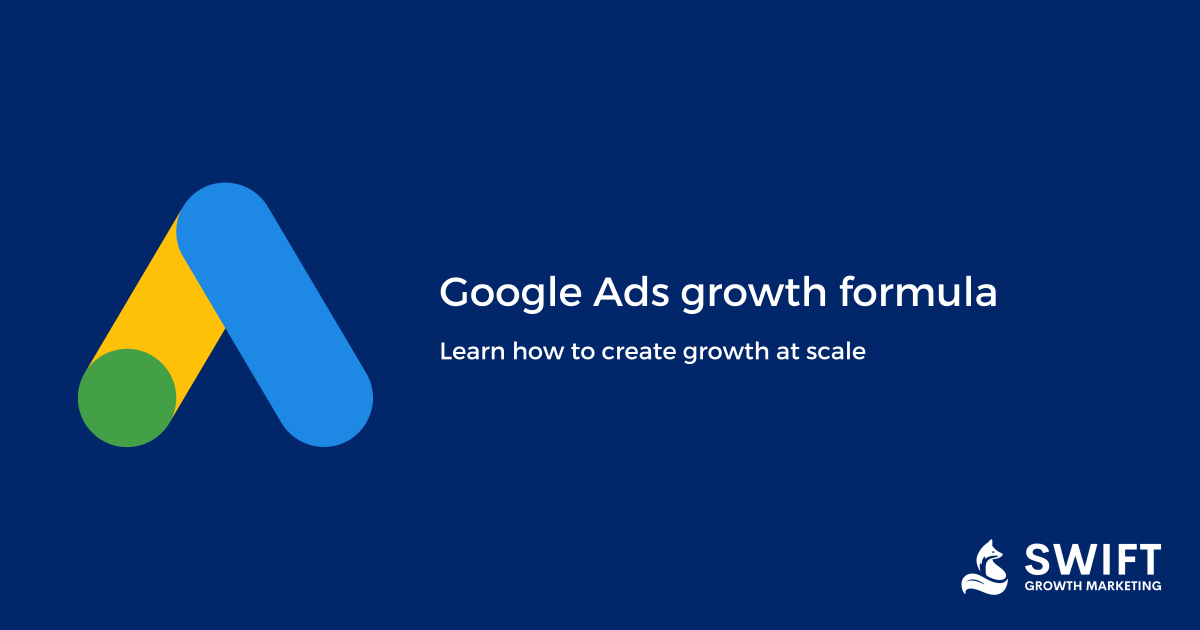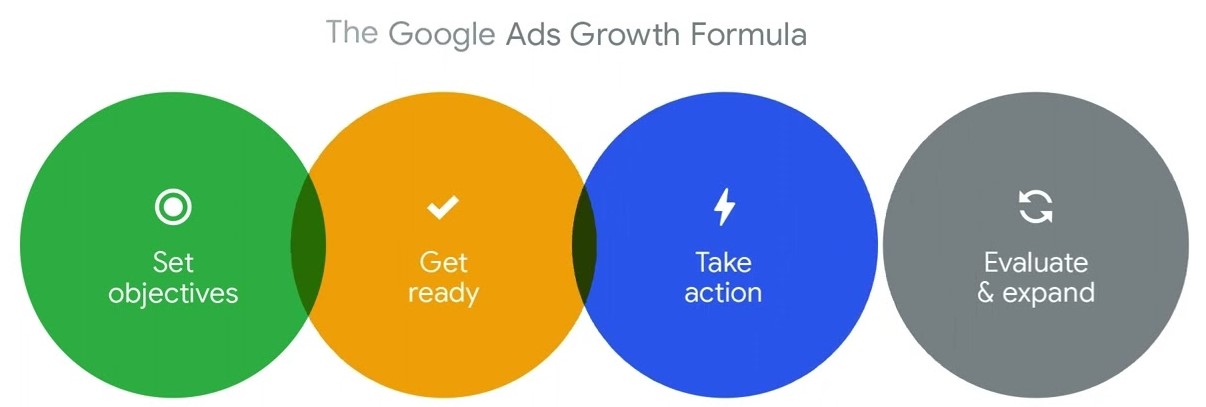
There are many ways to grow your business, but one of the most effective is using Google Ads. Google Ads (formerly known as AdWords) is a platform that allows you to advertise online and brings in customers who are actively looking for what you offer. The great thing about this type of advertising is that it’s fully customizable—and if you follow our step-by-step guide on how to grow with Google Ads using the Google Ads growth formula, we’ll show you exactly how to get started.
Meet the Google Ads Growth Formula

This free Google Ads Growth Formula guide will teach you how to grow online sales at scale through smart advertising strategies.
The Google Ads Growth Formula is a five-step process that helps businesses achieve real, measurable results with their marketing efforts. This formula has been used by thousands of companies around the world, including:
- Google AdWords Certified Partners such as WordStream and AdStage
- Startups like
- Five Stars (a customer review software company)
- Large enterprises such as Intuit (the makers of TurboTax)
Start by choosing your Google Ads goal
To get started, you need to choose your Google Ads goal. There are three main options:
- Grow online sales. This goal is for you if you already have a website and want to increase your digital sales.
- Generate leads. If you want to grow in-person appointments, website visitors, or phone calls from ads on Google Search or YouTube (or other channels), select this option.
- Grow in-store sales. If you have brick-and-mortar locations and want to drive people into stores through Google Ads campaigns, choose this option instead of the previous one—it lets advertisers create mobile location extensions that show when customers are nearby their physical store locations as well as text ads that lead back to the business’s website or app.
Pinpoint your objectives
Once you know how to target an audience and set up a campaign, your marketing efforts must be aligned to support your business objectives. Know what those objectives are before beginning any campaign or ad group!
Be clear on your key performance indicators (KPIs). How will you measure success? Your KPIs should align with each objective to indicate whether or not you’ve achieved them. For example: If gaining market share is one of the main goals of your advertising program, then impressions and clicks won’t be enough — ROAS (return on ad spend) will matter most. If establishing brand awareness is your goal instead, impressions may be more important than clicks since branded keyword searches don’t necessarily convert into sales immediately (or at all).
If we take a step back and look at how our advertising objectives stack up, it becomes clear that there are different types of objectives. Some top-of-the-funnel brand objectives include awareness, consideration, and preference. Middle-of-the-funnel performance objectives include website traffic, video views, and app installs. And the bottom of the funnel conversion objectives include transactions from your website or store location.
The key is to have the right mix of objectives that align with your strategies and overall business goals. How can you expect to get there if you don’t know what you’re trying to achieve? Setting measurable objectives helps guide your advertising efforts so you can track progress toward achieving them. This way, you’ll know exactly where your money is going when spending on advertising.
Lay the groundwork
You should have a solid understanding of your customers and how they buy from you today. They should be able to access information about your products or services through an intuitive user interface that helps guide them through decision-making.
Collect and connect your first-party data to Google Ads (AdWords)
First-party data is collected directly from website visitors, email subscribers, and app users on the website or in an app. This includes things like name, email address, age range, etc., which can be used for targeting ads at scale; knowing their interests so you can personalize content; sending newsletters with relevant offers; measuring brand awareness by tracking pageviews without having to rely on surveys; testing new product ideas with A/B tests without involving users outside of your company (because these can run afoul of GDPR privacy laws).
Measure the customer journey using Audience Insights
Audience insights let you see where people drop off along each stage of their buyer journey—before they become customers—so you know where we need more retargeting ads to convert visitors into buyers later down their path toward purchase.
Find your high-value customers Some customers bring more value than others, and your bidding should reflect that. Fine-tune your marketing strategy to go after the best ones—those who spend more time on your website often return or follow your brand on social media. They’re also likely to buy from you again later. You can also use audience insights for this: it utilizes machine learning to find similar people based on their interest in a topic or page category.
Create campaigns
Once you’ve identified your target audience, it’s time to set up a campaign. This is where you’ll be able to create your ads and keywords that will show up when someone searches for them.
We recommend starting with search ads to create campaigns that bring an accelerated return on investment (ROI). They let you capture existing demand from customers searching for your business or product—and the more people searching for what you offer, the better their chance of getting their money.
Then, once you’ve started showing up in search results and attracting clicks from people who already know what they want, start generating new demand by filling the top funnel with remarketing ads. These display targeted ads based on user’s previous experiences with your brand or website; so if someone visited one of your landing pages but didn’t purchase anything yet (or even sign up), these will help convert them into paying customers later down the road by showing them relevant offers based on their browsing history at various times throughout each day or week.”
Evaluate and expand
As your Google Ads campaign progresses, you’ll want to shift your focus from evaluation to expansion gradually. However, before expanding your campaign, optimizing your performance and testing new strategies is crucial.
Once you’ve established a strong customer base from your Google Ads campaign, it’s time to focus on optimizing the rest of your marketing funnel so that those leads convert into customers—and ideally, repeat customers! This is where many companies get stuck; they focus on one part of the funnel without thinking about how everything connects cohesively.
To make the most of your time, paying attention to the most critical metrics first is essential. Let Google find opportunities for you by setting up Smart Bidding, where our algorithms automatically analyze your data and adjust bids based on real-time signals like conversion rate or cost-per-acquisition.
Test, learn, and refine your way to success. Your ads may be performing well now, but they won’t always. As competition changes or new technologies disrupt your industry, you must keep testing new strategies. To do this effectively—and efficiently—there are a few things you should understand about your customer’s path to purchase:
- Learn from your top customers how long it takes them to convert on average, from the first time they see an ad until finally making their decision.
- Identify the main stages of your customer’s shopping journey and what they’re looking for.
- Test ads that speak to customers at each journey stage.
- Focus on relevant ads and content to improve the user experience and help customers find the information they need when they need it.
- Use remarketing lists and engaging formats like video or image carousels in your campaigns to connect with interested customers.
Don’t miss the opportunity to optimize your marketing funnel and expand your Google Ads campaign for even greater success!
Achieve your marketing objectives
Once you’ve become familiar with the Google Ads Growth formula, it’s time to apply what you’ve learned and achieve your marketing objectives. As a marketer, you aim to ensure that people buy products from your company. To do this, you need to:
- Understand how people find, buy and use products or services in their lives
- Understand how they search for information online related to these products and services
- Create content that provides an answer/solution and entices them into buying more of what they want!
For example, if you had a company that sold coffee makers, you could use Google Ads to promote your products. You would create an ad campaign targeting people who search for “coffee maker” or “buy a coffee maker.” These people are already interested in buying something like this but don’t have one yet.
Conclusion
To build a successful business, you must know how to attract customers. You also need a strategy that will help you keep those customers coming back. Google Ads can be one of the most effective tools for driving online sales because it’s easy and affordable for all businesses. The best part? Once you have set up your ads correctly to reach your marketing goals, little maintenance is required!

